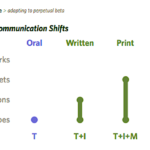To paraphrase Marshall McLuhan, every message has its medium and every medium has its message. That sums up my impression of our LearnTrends web conference which finished yesterday. Selecting the appropriate messages and media is becoming an essential part of facilitating learning. The other component is building or connecting to networks, social or otherwise. The major trend in workplace learning that I see is the merging of Learning & Working. The main driver is our ubiquitous access to networks. Our global 24 hour conversation was in fact a global village, still composed mostly of innovators and early adopters, but the tip of a connected iceberg.
Personally, I enjoyed the sessions but of course this medium is only good for a certain type of interaction. It could not be all things to all people. For instance, there were several media involved:
Synchronous Sessions (Elluminate) – good to get acquainted, hear some new ideas and feel like part of a larger movement. The text chat enables more people to have input without interrupting the current speaker, but it can get off topic. The session by Heike Philp on Pecha Kucha showed another way to make this medium more interesting, and fun, by adding constraints for the presenters.
Twitter – gets the word out about upcoming sessions and allows wider publishing of impressions. Using Twitterfall, or search, one can see the collected observations from many people and from this see some patterns. These are some of my observations I passed on via Twitter:
“I knew I was in a community of practice when my practice had changed,” heard in a discussion.
“If you shut down the training department, would it be missed?” a general question
“Try 2-3 low-cost approaches instead of one big (expensive) project- that way you can afford to fail,” from a presenter.
“Twitter is for surfing an ocean of information, not trying to understand fluid dynamics,” my own observation.
Blogs – like this post, blogs provide a more permanent record of what happened and more thought-out individual impressions, plus the option to connect or comment.
Social Networks – the LearnTrends community site provides a place to add a profile which is a handy way to put a face to a name. The main limitation of using Ning is the lack of wiki, and obvious weakness when creating a schedule on the fly with people in multiple time zones.
I’ve been attending, presenting and coordinating web conferences for over a decade now and each time I learn, or re-learn something. Whenever I go live on the Web I also realize that this active learning is necessary to really understand the medium. Looking back and observing is not enough to understand how networked learning can be facilitated. We learn through our practice.


The medium is the meaning .. we consume and create together ;-)
Yeah, I know it’s abstract, but it works for me …
Hi Harald,
A good capture of the atmosphere and I like your own observations on Twitter. Brilliant.
Personally I was amazed to see a very well organized live online conference come up so quickly and Jay baffles me as usual about his energy level even after a 20h mental marathon.
Some of the thoughts that struck me at the conference is the fact that those training department procurers often wished to be involved in the decision making process of the company and left helpless in the face of budget cuts and that perhaps the economic downturn may be the ultimate chance for social media to take over as cost effective training.
On the other hand, I was a bit left hanging by too much of the “so how do we convince the training officer of our super learning 2.0” approach of virtually every session of the whole conference.
Refreshing was Vance’s session connecting to the Earth Day Activists.
And here are my two pennies worth on the tool debate.
What I am sorely missing right now are ‘learning products’. To me a product has product specifications (specs) just as much as a computer has a list of specs or software has a list of features.
The fascination of Pecha Kucha for me is, that this simple idea could be patented and that it is a ‘product’, it has specs, the specs are ’20 slides auto advancing 20 sec’.
In the light of lots of IM software out there, a Tweet is a ‘product’ because it has 140 characters.
So, where right now in the vast ocean of fuzzy connectivism and informal learning experiences are the products?
We are always talking about tools. Is this because these seem to be “the products” out there right now?
Where are the learning products/ services that make headlines just as Pecha Kucha does?
Rgds Heike
Hi Heike:
Tools are technology, as are processes, especially if we define technology as “the application of organized and scientific knowledge to solve practical problems.” I agree that we need more examples of technology in action, or praxis, in our field. Defining specific constraints, based upon our understanding of learning, is one approach that has much potential, in my opinion.